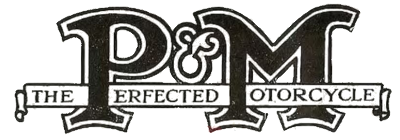


The improved form of front brake.

The 1921 P. and M., to which several refinements have been added.
New Spring Drive and Modified Oil Pump among the Detail Improvements.
THE 1921 P. and M. is an interesting machine, which shows the result of five years' intensive motor cycle manufacture during the war, and has proved so entirely satisfactory that it is to remain the company's sole model.
Although the engine is not designed for excessively high speeds, it has been considerably improved as regards power output in comparison with its predecessor. Thanks to the horizontally-arranged radiating fins and the design of the combustion chamber and valve ports, the 500 c.c. engine will easily pull a sidecar without the slightest tendency to overheat. Since also the frame and forks are of abnormal strength, the machine itself is well up to sidecar work, while the lugs incorporated in the construction enable the sidecar to be attached at four points on either side of the machine. In a word, the P. and M. is an efficient double-purpose mount.
A mechanical oil pump, the efficacy of which was proved in a recent officially observed A.C.U. trial, has been slightly modified in design. The oil pipe leading from the tank is now situated at the top, find a new cap is provided at the end, which has two internal seatings or faces preventing any possibility of leakage. Owing to the great leverage obtained on the kick-starter, and the fact that it acts directly on the engine-shaft, very little effort is required to get the engine to fire; and, as an example of the refinements to be found on the machine, it may be mentioned that rubber buffers are provided against one of which the starter pedal rests when out of use, while it comes up against the other one at the furthest end of its travel. The chain drive and substantial and easily detachable chain covers remain unaltered, but an improvement in the transmission has been incorporated in the shape of a new transmission shock absorber. This consists of a sleeve rigidly attached to the engine-shaft carrying both engine chain sprockets; a peg held by means of a spring projects through slots in the fixed sleeve, and engages with two V-shaped notches in the loose-fitting sprockets. Oil holes are provided at the back of the device for purposes of lubrication.
Some improvement has also been effected in the design of the brakes. Not only is the excellent rear wheel contracting band brake, actuated either by a hand-operated ratchet lever or a brake pedal, retained, but a new front brake has been designed, consisting of a long shoe fitted with two compressed Ferodo blocks engaging with a dummy belt rim. The system of braking is especially suitable for sidecar work, as. in addition to two powerful and efficient brakes, the ratchet lever allows the machine to be left standing on a gradient with absolute safety.
Good Mudguards.
Throughout the whole machine great attention has been paid to detail. Mudguarding has been specially studied. The design of the clips fastening on the rear mudguard is particularly sound, while the front guard is completely valanced, and is provided with a large splashguard. The finish is as good as ever, and the machine still remains one of the best equipped, best turned out, and most reliable mounts on the market.
The following details may be of interest: Weight, 255 lb.; ground clearance, 5½ in.; petrol capacity, 1¾ gallon; oil capacity, 3½ pints. The tyre equipment is 2½ in. anti-skid Kempshalls. The makers claim that the petrol consumption with sidecar and passenger is 70 miles to the gallon, and 1,200 miles to the gallon of oil, and these figures were more than substantiated in the recent A.C.U. tests.
The Motor Cycle November 18th, 1920. Page 596

Component parts of the P. & M. cush drive device.
Rubber buffers on the P. and M kick-starter which act as stops at either end of the stroke.
P. and M. (Stand 74.)
3½ h.p.; 83x89 mm. (498 c.c.); single-cylinder four-stroke; side-by-side valves; mechanical lubrication; B. and B. carburetter; E.I.C. chain-driven magneto; two-speed expanding clutch gear; chain drive; 26 x 2¼ in. tyres. Price £125.
Phelon and Moore, Ltd., 4, Berners Street, London, W.l.
Minor alterations only have been effected in the popular 3½ h.p. P. and M. The front brake is now a shoe of compressed Ferodo operating in a dummy belt rim on the wheel, and another improvement is found in the cushioning device incorporated in the engine sprocket. A feature of this machine is, of course, the mechanical lubrication, which consists of a pump positively driven by a worm formed on the exhaust cam wheel. This pump forces oil alternately to the cylinder and to the big end, and not the least of the advantages attained is the gain in oil economy. Another interesting feature is the hand brake ratchet in connection with the brake pedal, by means of which the contracting band rear brake may be left on without the driver having to keep a continual pressure upon the pedal. For sidecar use in hilly country, this is a refinement which proves particularly useful.
If it is so desired, Lucas dynamo lighting may be provided as an extra, and the small cylindrical dynamo is housed over the crank case immediately behind the cylinder and driven by an enclosed chain from the magneto drive.
Two sectioned engines are also exhibited, and the operation of the mechanical lubricator is demonstrated by an electrically-driven model causing considerable interest and attracting a crowd of spectators. Another interesting small point is that the tank is now finished in a benzole resisting enamel, a curious fact being that only a green finish can be obtained in this-special material. A subsidiary hand pump is also housed in the tank, to supplement the mechanical lubricator should, occasion arise.
Olympia Show. The Motor Cycle, December 2nd, 1920. Page 712